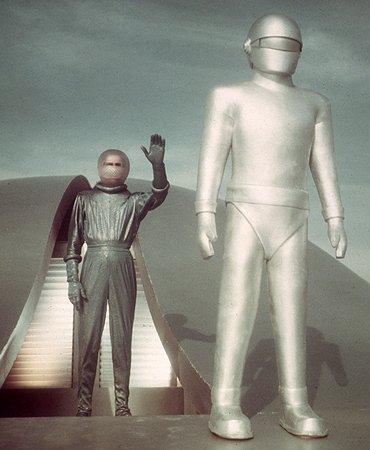
Are we alone in the universe? That's a question that has been asked with greater frequency and intensity recently, corresponding with Humanity's first faltering steps into outer space. Are we about to enter an interstellar community?
If you ask me, the answer is “no.” The time scales involved are just too immense. Allow me to explain. Let's be optimistic and assume that most stars have solar systems like ours around them. Let's be more optimistic (starry-eyed?) and assume that a good portion of these solar systems possess Earth-like planets that can support life. There are more than 100 billion stars in our galaxy—perhaps as many as 300 billion. Surely, around some of these stars, intelligent life must have evolved.
I don't dispute any of the above, actually. I think life is a fair inevitability given the right original conditions, and once you have a creature that is multi-cellular, eats other creatures, and is mobile, you have a creature that would benefit from some kind of brain. Once the brain gets started, it seems likely that it would continue to grow in the creature's descendants as intelligence is generally a useful trait.
Here's the problem: Homo Sapiens, if we are being charitable, has been a species for about a million years. We have been a civilized society (again, charitably) for 6,000 years. Industrialization began 200 years ago, and space travel is exactly one year old. At this rate, we'll have a window of a few hundred or maybe even a thousand years during which we will be spacefaring and recognizably human, whereupon we will “graduate” to whatever the next step is. Or we'll blow up the Earth when the Federation of Atomic Scientists' clock strikes Midnight.
That few thousand years compared to the entire history of the universe is a razor thin slice. It's the width of a penny atop the Empire State Building. Sure, there are probably intelligent aliens out there, but odds are extremely high that they are either behind us, and therefore limited to their planet, or beyond us, and therefore uninterested. Humanoid aliens with technological levels similar to ours make decent fiction, but they might as well be fantasy, not science fiction.
If we ever do meet an alien civilization, it is bound to be unrecognizably alien and bewilderingly beyond our comprehension technologically. Not many authors have tackled the subject, but some stories do exist. Clarke's Childhood's End is perhaps the archetypical example. Much of that book is devoted just to the effects this contact would have on humanity: the humbling, the shaming, the frustration, and the technological/sociological benefit.

Another example, and the catalyst for this article, is William Tenn's Firewater. This story actually came out six years ago in Astounding (where I missed it), but it was recently reprinted in a Tenn anthology called Time in Advance. Tenn is a good writer; I have come to look forward to his stuff, and the anthology is worth picking up.
In Childhood's End, the aliens at least had the decency to talk to us. In Tenn's story, they appear simply as jiggling dots in ethereal brown or umber bottles floating above our cities. They hang in the sky, watching us, intentions unknown. If we attack them, with rocks or missiles, it has no effect. Worse, it sometimes invites retaliation—the destruction of the weapon and/or the weapon's user.
Yet, there are some people who can communicate with them. These are the Primes—people who have lost their sanity trying to conform to the aliens' thought patterns. In doing so, they have acquired the ability to do tremendous psionic feats, but they are also quite mad. The Primes live on reservations camped out next to a congregation of aliens in Arizona.
The Primes have figured out a number of technological and sociological advances, though they do not apply them. It is a kind of game to them. Moreover, because dealing with the Primes can be so dangerous, due to their instability and contagious insanity, dealing with them is highly illegal.
One person, Algernon Hebster, is willing to take that risk. A highly successful businessman, he has perfected the art of trading with the Primes, exchanging various artistic gimcracks for new technologies: washless dishes, better televisions, finer clothing, etc. But his situation is becoming increasingly untenable. The United Humanity government is hot on his trail with an investigation into his illegal activities and the atavistic Humanity First movement is plotting a revolution with Hebster as Enemy No. 1.
I particularly liked Hebster's (admittedly over-simple) analogy for the situation. He likens Earth's contact with a vastly more-technologically advanced civilization to the (devastating) meeting of the American Indians and the Europeans. The native Americans generally responded in one of two ways: they either resisted the Europeans, futilely (as Humanity First wishes to do in the story), or they were subjugated, accepting the European firewater and becoming worn-out shadows of themselves.
There was a third kind of Indian, however (in Hebster's analogy). This one didn't fight the Europeans nor had any interest in firewater. What was exciting to this Indian was the bottle in which the firewater came. This artifact represented a product of a technology far beyond what was possible for the natives, and it was something that could be traded for, if one were canny enough to develop goods that the Europeans wanted. Hebster notes that after a wretched period of adjustment, the American Indian cultures adapted to the new situation and managed even to profit from it. Perhaps humanity as a whole could do the same, if a good that the aliens wanted could be found and developed.
How Hebster deals with this crisis and ultimately is the lynchpin to establishing real contact with the aliens, makes for an excellent 50 pages of reading. It is an ambitious story, and one of the few attempts to posit a truly alien species and the likely effects the meeting with such a race would have on humanity.
Find it. Read it. Let me know what you think.
(Confused? Click here for an explanation as to what's really going on)
This entry was originally posted at Dreamwidth, where it has comments. Please comment here or there.
